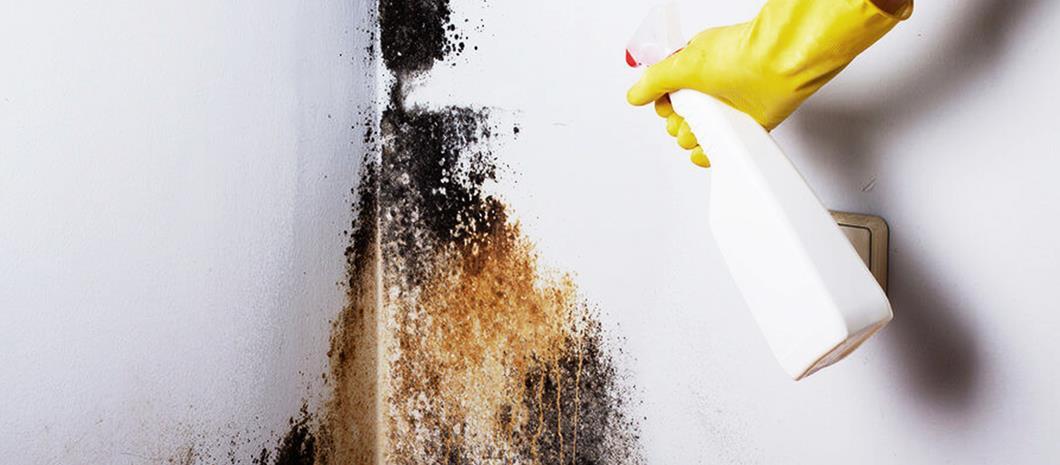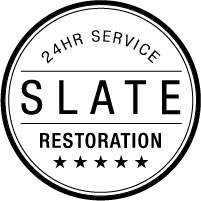How to Remove Mold in Your Home

Even though we live in the desert, we aren’t immune to mold. In fact, mold spores are found everywhere and it would be nearly impossible to keep yourself and your family from ever encountering mold in at home, at work or in the outdoors. However, if you find a moldy patch in your home, or you find that you have an extreme mold problem, you should have it removed, either by cleaning it yourself or hiring a professional.
If the moldy area in your home is less than a 3 ft. by 3 ft. patch and it is on a non-porous surface, you should be able to handle the cleanup yourself, but if the mold covers more than 10 square feet, it has penetrated a porous surface (like drywall), or if you have allergies, asthma, respiratory disease or have other health problems then you should call a professional.
The first step in mold cleanup is fixing the source of the moisture, otherwise it will just keep coming back. Common sources of moisture in homes are bathrooms that aren’t well ventilated, leaky pipes and faulty seals near windows and doors. Once you have fixed the source of the problem and you’re ready to take on the mold, you should follow these steps to keep yourself safe.
WHAT TO WEAR
When cleaning up mold, you should wear a breathing respirator with HEPA cartridges so that you don’t breath in mold spores. The EPA recommends an N-95 particulate respirator as the minimum protection that you should use when cleaning up mold. You can buy one of these at most home stores for about $8.
You should also wear clothes that cover your skin completely (long sleeves and long pants) and that can be washed as soon as you are done cleaning up the mold.
Wear gloves. They should extend to the middle of the forearm if possible, but rubber gloves will do if you don’t have long ones. Dish gloves can be used if you are just using warm water and detergent. But if you are using stronger chemicals, like chlorine bleach, you should wear gloves made of natural rubber, neoprene, nitrile, polyurethane, or PVC.
Don’t touch mold with bare hands.
Wear goggles. It wouldn’t be any fun to get mold spores in your eyes, so goggles without ventilation holes are the best.
WHAT YOU WILL NEED:
- N-95 breathing respirator
- 3 spray bottles
- Clean rags and a scrubber you don’t mind throwing away
- Ammonia-free household cleaner
- Latex or rubber gloves
- Dehumidifier
- HEPA-Vacuum (not one for home use, you can rent one locally)
- Household bleach
MIXING YOUR SOLUTIONS
Once you have gathered all your items, you can mix the solutions you will use in the mold cleanup process. But be careful while you are playing mad scientist. NEVER mix a cleaner that contains ammonia with bleach. Doing this will create toxic gas.
In one spray bottle, mix the household cleaner and water according to the directions on the bottle. In the second spray bottle, prepare a 1:9 mixture of bleach to water. One part bleach to 9 parts water. Use gloves for this step and be careful to not spill on clothing, furniture or carpet. The chlorine in the bleach can reduce mold and bacteria where you spray it. Fill the third bottle with warm water.
Preparing the Area
If there is mold under or in your carpet, you will probably need to pull it up and throw it away. Wrap it in plastic and double bag it before throwing it out.
Depending on the size of the mold problem, you may need to tape off the section of the house you are working on with plastic sheets (at least 4 mm thick) and cover windows and vents. If you aren’t sure how big of a mold problem you have, give a restoration company a call. If you are in Arizona, Slate Restoration will come out and look at your problem free of charge and we will let you know truthfully whether or not you need to hire a professional or do the job yourself. And we can advise you on whether or not you will need to tape off the room.
START SPRAYING
Starting from the top of the area and working your way down, spray the household cleaner solution and let it sit for a few minutes. You can then use your disposable rags or scrubbers to scrub away the mold. Once you have scrubbed it away, use your clean water sprayer to give it a rinse. Then wipe with a clean towel. Now spray with your bleach mixture, let it sit for 15 minutes, then wipe down with a clean cloth. Once you wipe that down, you can repeat these steps if there is still visible mold. There may be some discoloration from the mold that you won’t be able to get rid of.
When you are done cleaning the moldy areas, let them dry completely then use a HEPA vacuum to vacuum the affected area thoroughly. Dispose of the contents of the vacuum bag as soon as you are done vacuuming.
Now you can paint over the surface. You may want to use a paint that contains a mildewcide or fungicide.
THINGS TO KEEP IN MIND:
- Turn off your furnace or air conditioner before starting so more spores don’t get blown around.
- Keep kids and pets out of the area you are working on.
- Don’t eat or drink anything in the area you are working and don’t eat or drink after you are done until you have had a chance to shower and change your clothes.
- Use a dehumidifier to keep the humidity in your house below 45 percent at all times. This will prevent more mold from growing in the future.
WHAT NOT TO DO
Don’t just paint over the mold before cleaning it up. Some people think that some types of paint, like Kilz, will stop the spread of mold or that it will kill mold that it is painted over. This is only a band-aid fix and your mold problem will keep returning until you fix the problem causing moisture to accumulate in the area that mold is growing. Once you have fixed the problem and the surface is clean and dry, you can paint it with this type of paint to prevent more mold from growing in the future.
Painting over moldy surfaces can make it more difficult for you to see if the mold is spreading. It’s better to try to clean the surface as well as possible yourself. If you still can’t get rid of the mold, then you should call a mold restoration specialist. A professional will be able to replace your drywall, floorboards and other areas damaged by mold.
IF ALL ELSE FAILS, CALL A PROFESSIONAL
If you still aren’t sure whether or not you should take on your mold problem on your own, give us a call at 480-550-2511. At Slate Restoration, we pride ourselves on providing honest advice based on our knowledge and experience. We are happy to take a look at your mold problem even if you don’t end up hiring us ultimately to fix it.
